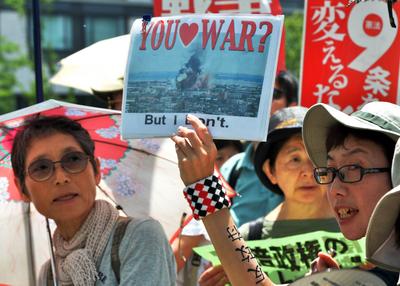Japan is one of the top military spenders, ranked 8th globally by Stockholm International Peace Research Institute, and spends between US$48 billion and US$50 billion on defence per year. Japan has leveraged its high-tech commercial industries to develop a self-defence force that — although untested in combat — is capable of employing potent military force.
The United States has long been interested in seeing Japan adjust its self-defence policy to enable it to participate more robustly in alliance activities. In 2005, Australians had to operate alongside the Japanese task force deployed to southern Iraq because constitutional provisions precluded them from using force. Today, that kind of embarrassing dependence on others is increasingly unacceptable to Japanese conservatives.
Japan’s revision of its collective self-defence policy is likely to have a transformative effect on the East Asian geostrategic equation. Japan and the US could potentially plan together and test relevant capabilities more effectively. Countries such as the Philippines and Vietnam will be weighing up the potential ramifications of a new Japanese defence policy as they confront China in the South China Sea.
Japan’s move to revise its self-defence policy can also be viewed as a quid pro quo for US President Obama’s commitment to guarantee the security of the Senkaku/Diaoyu Islands.
Still, Abe has had to circumscribe the exercise of collective self-defence to bring his coalition partner, the New Komeito, on board. But the cabinet’s decision to acknowledge Japan’s right to exercise collective self-defence represents a weakening of the logic of ‘passive pacifism’ that has underpinned Japan’s postwar security policy.
If the necessary amendments to related legislation pass both houses of parliament, Japan’s military planners would also be better placed to cooperate with other regional forces under the US Pacific Command, including Southeast Asian states. Implementing the lessons learned from the US–Japan Operation Tomodachi (‘Friends’) following the 2011 Tohoku triple disaster could also enhance the quality of joint operations, showing clearly how humanitarian assistance and disaster-relief efforts spill over into military planning and enhanced interoperability. Moreover, the Abe administration is already concentrating its diplomatic efforts, including defence aid, towards ASEAN in a clear demonstration of its priorities in the region.
Some parties are ambivalent if not overtly hostile to this change. Opponents within Japan are deeply troubled by the proposed changes to Japan’s self-defence policy. Pacifists see this as more evidence of a forced resurgence of a martial spirit, manufactured by the Abe government. In this respect, Abe is his own worst enemy: he desires popular support for a ‘normal’ military posture for Japan, but he circumvents parliament and public opinion in order to achieve his policy goals. Abe has astutely tried to mobilise the ‘proactive pacifism’ norm to convince ordinary citizens that enhanced military capability can sit comfortably with a pacifist national identity. But his persistent revisionist statements undermine his objectives here too — and this is why the victim nations of Japan’s wartime acts find it difficult to accept that Japan’s military ‘normalisation’ is benign.
South Korea has expressed concern over Abe’s attempts to undermine official recognition of the trauma ‘comfort women’ suffered at the hands of the Imperial Japanese Army during World War II. Similarly, China has pointed to Abe’s denial of Japanese atrocities against Asian nations during World War II as an indicator of why Japan must not be permitted the status of a ‘normal’ military power today.
China today has sought to manage its disputes through bilateral channels rather than multilateral forums, to maximise its diplomatic and strategic advantage. How Japan’s changed role will affect these dynamics remains to be seen. But there is little doubt that China’s actions in the South China Sea are casting a positive light on Japan’s pro-ASEAN policy stance. This was the key message drawn from the recent Shangri-La Dialogue speech by Abe.
In light of changing power dynamics in East Asia, the United States has been eager to adjust its ‘hub-and-spokes’ alliance relationships in East Asia. This has also contributed to heightened collaboration between Australia and Japan. For example, Japan can gain access to bilateral and multilateral training areas and activities in Australia’s wide brown land and Australia can reap the benefits of access to advanced Japanese military technology, particularly submarine technology.
The EPA and closer security ties between Japan and Australia may constitute a new template for the next phase of the ‘rebalance’. But this need not be a zero-sum game. Efforts should be made to embrace China on the basis of mutual interests as demonstrated during the search in the southern Indian Ocean for the missing Flight MH370. There is much that can be done as participants in joint military exercises where interests and concerns overlap, including alongside Japan and the United States.
Dr John Blaxland is Senior Fellow at the Strategic and Defence Studies Centre, the Australian National University.
Professor Rikki Kersten is Dean at the School of Arts, Murdoch University.

